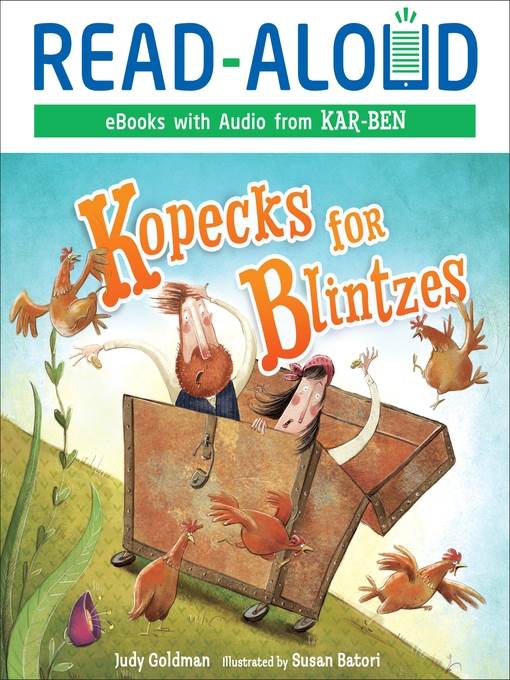
Kopecks for Blintzes
فرمت کتاب
ebook
تاریخ انتشار
2016
Lexile Score
610
Reading Level
2-3
نویسنده
Susan Batoriشابک
9781467796095
کتاب های مرتبط
- اطلاعات
- نقد و بررسی
- دیدگاه کاربران
نقد و بررسی

February 1, 2016
Goldman (Whiskers, Tails, & Wings) and newcomer Batori take readers to the famous, folkloric town of Chelm, renowned for the foolishness of its residents. In this retelling, about how Chelm ended up with 13 commandments instead of the usual 10, a melamed (teacher) named Yankl and his wife, Gitele, agree to place spare kopecks into a trunk each day to save enough money to buy ingredients for blintzes to celebrate Shavuot. Neither spouse ends up putting any kopecks in the trunk, figuring the other’s contributions are sufficient. When the trunk is opened, Yankl and Gitele believe they have been robbed, argue, and get trapped in the trunk, which rolls downhill, disrupts the town, and leads the rabbi to announce three extra commandments. Batori’s caricatured illustrations create a sweetly dimwitted citizenry; in one of the funnier scenes, the sun itself looks on with horror as the trunk careens into town. But even given Chelm’s nonsensical reputation, the added commandments (such as “Thou shalt allow no melamed of Chelm to make blintzes”) are more likely to evoke head-scratching than laughs, resulting in an anticlimactic ending. Ages 3–8.

January 15, 2016
A poor teacher and his wife worry that they won't be able to afford to celebrate the Shavuot holiday with traditional blintzes and hatch a savings plan with good intentions but ridiculous results. Gitele and Yankl are residents of Chelm, populated by the wisest fools. They take an old, dirty, wheeled trunk, cut a hole in the top, and vow to each throw in a coin every day, thus collecting enough to shop for and make blintzes. But left alone, each spouse relies on the other to do the saving, so when the trunk is opened at the end of two weeks, only the original two coins are inside. An argument ensues, and in the scuffle, the couple ends up in the trunk, which then closes and begins to roll down the hill. As it approaches the synagogue, Gitele and Yankl's screams from within cause the townsfolk, comically depicted with wide necks and long noses, to fear that a dybbuk, or demon, is inside. The trunk is opened and the disoriented couple's story prompts the rabbi to forbid a teacher living on a hill with a trunk on wheels from making blintzes. While no explanation of either the holiday or the reason for its customary meal is given, the absurdity of the story and its nonsensical conclusion will be appreciated by those familiar with these Eastern European noodlehead tales. It's hard to go wrong with a story about Chelm. (author's note) (Picture book. 4-6)
COPYRIGHT(2016) Kirkus Reviews, ALL RIGHTS RESERVED.

June 1, 2016
PreS-Gr 2-This story is based on a Jewish folktale of Chelm, the town of wise fools. Poor Yankl and Gitele can't afford to make blintzes, a traditional treat for the holiday of Shavuot. They agree to put aside a kopeck (Polish coin) each day until they have enough, but each spouse assumes that the other is doing so and holds back his or her own cash. A slapstick ending ensues, with an argument, a wild ride down the hill in a wheeled trunk, and the rabbi's wisely foolish new commandments against living on hills, making blintzes, or owning wheeled trunks. This story must have seemed hilarious back in the shtetl, but the new version falls somewhat flat. Contrary to today's storytelling tastes, Yankl and Gitele are not very sympathetic characters and they gain nothing from their experience. The foolishness of the Chelmites includes superstition about dybuks, a foreign concept for the modern era. Readers learn little about blintzes and less about Shavuot. And the family never does make blintzes, having to eat them at the rabbi's house instead. The illustrations are cartoony and comical, befitting the mood of the story, but there is one problematic element. The rabbi is frequently portrayed wearing not only a kippah (Jewish skullcap) but also a flowing headdress that appears to be a prayer shawl worn keffiyeh-style. Jews in Eastern Europe did not wear such headgear, especially outside the synagogue. The author's note misses the opportunity to talk about blintzes or Shavuot, focusing only on the folklore of Chelm. In addition, the source of the folktale is never credited. VERDICT Barbara Diamond Goldin's A Mountain of Blintzes is a more positive Shavuot story based on the same folktale.-Heidi Estrin, Congregation B'nai Israel, Boca Raton, FL
Copyright 2016 School Library Journal, LLC Used with permission.

























دیدگاه کاربران